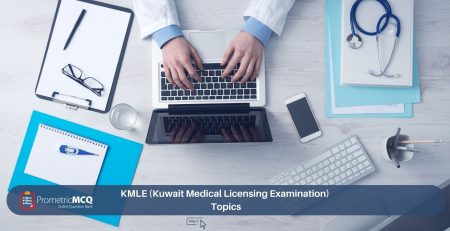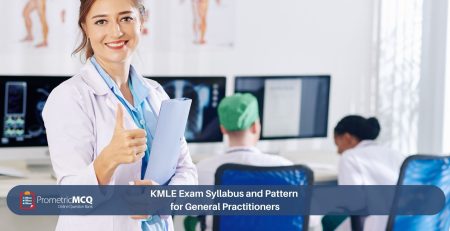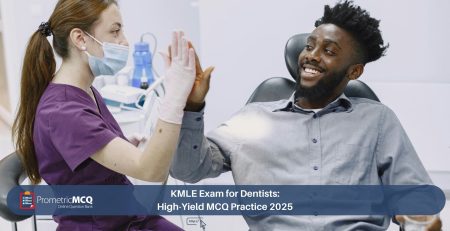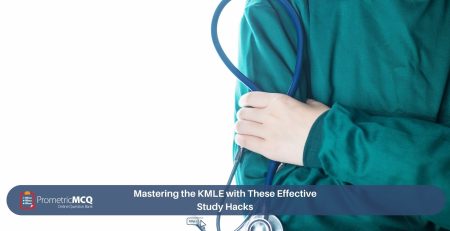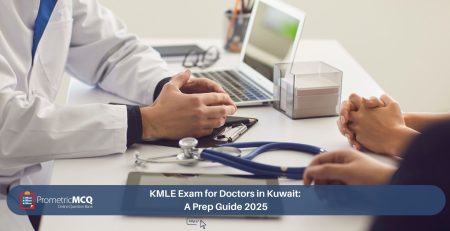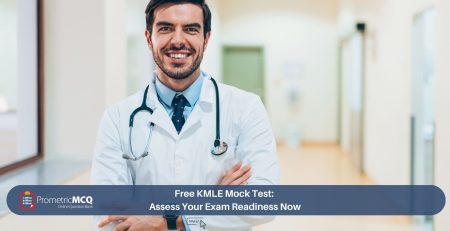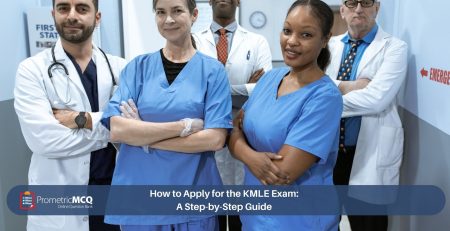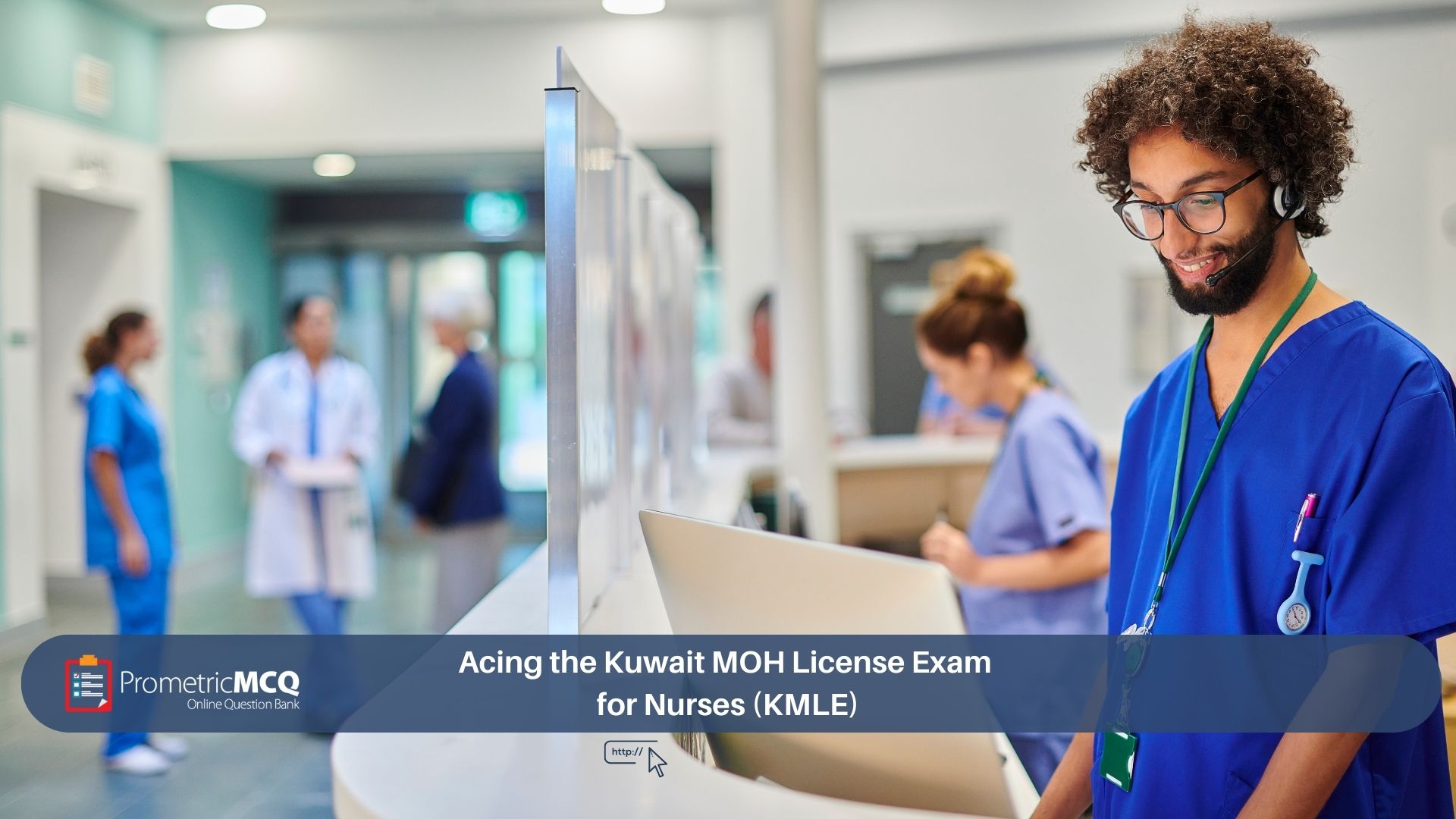
Acing the Kuwait MOH License Exam for Nurses (KMLE)
fatima@prometricmcq.com2025-09-19T21:44:32+00:00Table of Contents
ToggleAcing the Kuwait MOH License Exam for Nurses (KMLE) – 2025 Guide
For international nurses, Kuwait represents a land of immense professional opportunity. Its rapidly advancing healthcare system, commitment to quality care, and multicultural environment make it a highly desirable destination. However, the path to practicing as a registered nurse in Kuwait goes through a critical gateway: the Kuwait Medical Licensing Examination (KMLE) for Nurses, administered by the Ministry of Health (MOH). This exam is the cornerstone of the nation’s regulatory framework, ensuring that every nurse possesses the essential competence, critical thinking skills, and commitment to patient safety required to join its healthcare workforce.
The KMLE is not a simple test of textbook knowledge. It is a sophisticated, scenario-based examination designed to evaluate your clinical judgment in real-world situations. Success is less about memorizing isolated facts and more about your ability to apply the nursing process (ADPIE), prioritize care, calculate medications accurately, and make sound decisions under pressure. To ace this exam, you need more than just knowledge; you need a strategy.
This ultimate 2025 guide has been meticulously crafted to be your definitive resource for conquering the KMLE Nursing Exam. We will dissect the exam’s pattern, provide a deep dive into the high-yield syllabus topics, and arm you with proven strategies for tackling clinical MCQs. Featuring realistic sample questions with exhaustive rationales and a comprehensive 10-point FAQ, this guide is your all-in-one tool to transform preparation into a confident pass, paving the way for your nursing career in Kuwait.
Key Takeaways for Acing the KMLE Nursing Exam
- Patient Safety is the #1 Priority: Every question, in some way, tests your ability to provide safe care. This includes medication rights, infection control, and fall prevention.
- Master Prioritization & Delegation: Be prepared to answer “Who do you see first?” or “What can you delegate?” questions using frameworks like ABCs and Maslow’s Hierarchy.
- Flawless Pharmacology Calculations: Medication dosage calculation questions are guaranteed. They require 100% accuracy. Practice until they are second nature.
- Know Your Fundamentals: A rock-solid understanding of nursing fundamentals—from the nursing process to fluid & electrolytes—is the foundation for answering complex questions.
- Think Like a Test-Maker: The exam is designed to test clinical reasoning, not just recall. For every scenario, ask yourself, “What is the safest and most immediate nursing action?”
Deconstructing the 2025 KMLE Nursing Exam Pattern
A successful strategy is built on knowing the exam’s structure inside and out. The KMLE for Nurses follows a standardized international format, administered by Prometric on behalf of the Kuwait MOH. A solid understanding of this is a key part of your guide to the Prometric exam for nurses.
1. Test Format and Duration
The KMLE is a Computer-Based Test (CBT) consisting of 150 Multiple-Choice Questions (MCQs). You will have 3 hours (180 minutes) to complete the exam. This averages out to 1 minute and 12 seconds per question, making time management a critical skill you must develop during your practice.
2. Scoring System
The exam is graded on a simple Pass/Fail basis. The Ministry of Health does not provide a numerical score. The unofficial passing threshold is generally considered to be around 60%. Crucially, there is no negative marking. This means you must attempt every single question, as an educated guess is always better than leaving an answer blank.
3. Question Style
The questions are almost exclusively scenario-based. You will be presented with a clinical vignette describing a patient’s situation and asked to make a decision. The questions are designed to test your ability to apply knowledge, analyze data, and evaluate outcomes—the higher levels of Bloom’s taxonomy.
High-Yield Syllabus Domains for the KMLE Nursing Exam
Your study plan must be comprehensive, but your focus must be strategic. The exam covers the entire scope of general nursing practice, with a heavy emphasis on the following high-yield domains.
| Core Nursing Domain | High-Yield Topics and Key Concepts for 2025 |
|---|---|
| Fundamentals of Nursing | The Nursing Process (ADPIE), ethical and legal principles (confidentiality, consent, scope of practice), vital signs interpretation, fluid & electrolyte balance/imbalance (hypo/hypernatremia, kalemia, calcemia), IV therapy complications (phlebitis, infiltration), wound care, and pressure ulcer staging. |
| Medical-Surgical Nursing | This is the largest and most critical domain. Management of patients with cardiovascular (MI, HF, HTN), respiratory (Asthma, COPD, Pneumonia), endocrine (Diabetes, DKA, Thyroid disorders), neurological (Stroke, Seizures), and GI/Renal disorders. Pre-operative and post-operative care is a major focus, including preventing complications like DVT and atelectasis. |
| Pharmacology & Medication Safety | Medication dosage calculations (oral, IV, drip rates) are guaranteed. You must know the “10 Rights” of medication administration, major drug classes (e.g., anticoagulants, diuretics, antibiotics, insulin), their mechanisms, and common side effects. Recognizing and managing adverse drug reactions is key. |
| Patient Safety & Infection Control | Standard, contact, droplet, and airborne precautions. Correct use of Personal Protective Equipment (PPE). Fall prevention strategies, safe patient handling, and recognizing the early signs of critical conditions like sepsis and anaphylaxis. This is a theme that runs through the entire exam. |
| Maternal & Child Health (Pediatrics & OB/GYN) | Maternity: Antepartum, intrapartum, and postpartum care. Recognizing complications like pre-eclampsia and postpartum hemorrhage. Pediatrics: Newborn assessment (Apgar), pediatric developmental milestones, vaccination schedules, and managing common pediatric illnesses like dehydration and respiratory infections. |
| Leadership, Management & Delegation | Prioritization of care among multiple patients (e.g., stable vs. unstable). Principles of effective delegation to unlicensed assistive personnel (UAP). Inter-professional communication techniques (e.g., SBAR). |
A Strategic Guide to KMLE MCQs: Sample Questions & Rationales
Let’s put this theory into practice. These sample questions reflect the style and complexity of the real KMLE exam. The best way to improve is with a dedicated bank of nursing MCQs.
Question 1: Prioritization of Care
A nurse on a medical-surgical unit has just received the morning report. Which of the following patients should the nurse assess first?
- A patient with type 2 diabetes who has a pre-breakfast blood glucose reading of 150 mg/dL.
- A patient scheduled for a colonoscopy at 10:00 AM who needs to complete their bowel prep.
- A patient with pneumonia who has a new-onset of confusion and an oxygen saturation of 88% on 2L of oxygen.
- A patient who is 2 days post-op from a cholecystectomy and is complaining of 6/10 incisional pain.
Correct Answer: C
Rationale: This question tests your ability to prioritize using the ABCs (Airway, Breathing, Circulation) and identifying the most unstable patient. The patient with pneumonia has a change in mental status (confusion) and a low oxygen saturation (hypoxia), indicating a critical issue with breathing and gas exchange. This is a life-threatening situation that requires immediate assessment and intervention.
Distractors:
A: While the blood sugar is elevated, it is not a critically dangerous level for a diabetic patient and can be addressed after the unstable patient is seen.
B: This is a routine, scheduled task.
D: Post-operative pain is expected and needs to be managed, but it is not as life-threatening as hypoxia and confusion.
Question 2: Pharmacology & Medication Safety
A physician orders 1000 mL of 0.9% Normal Saline to be infused over 8 hours. The IV tubing has a drop factor of 15 gtt/mL. The nurse should set the manual IV infusion to run at how many drops per minute?
- 21 gtt/min
- 25 gtt/min
- 31 gtt/min
- 42 gtt/min
Correct Answer: C (31 gtt/min)
Rationale: This is a standard drip rate calculation. The formula is: (Total Volume in mL × Drop Factor) / Total Time in minutes.
Step 1: Convert hours to minutes: 8 hours × 60 min/hour = 480 minutes.
Step 2: Plug the numbers into the formula: (1000 mL × 15 gtt/mL) / 480 min.
Step 3: Calculate the numerator: 1000 × 15 = 15,000.
Step 4: Calculate the final rate: 15,000 / 480 = 31.25 gtt/min.
Step 5: Round to the nearest whole number: 31 gtt/min.
Question 3: Infection Control
A nurse is preparing to enter the room of a patient who has been placed on airborne precautions for suspected pulmonary tuberculosis. Which piece of personal protective equipment (PPE) is most essential for the nurse to wear?
- Surgical mask
- Gown and gloves
- N95 respirator
- Face shield
Correct Answer: C (N95 respirator)
Rationale: Airborne precautions are used for diseases transmitted by very small airborne particles (droplet nuclei) that can remain suspended in the air for long periods. Tuberculosis is the classic example. A standard surgical mask is insufficient to filter these small particles. The nurse must wear a specially fitted N95 respirator (or higher level of protection) to protect their respiratory tract from inhaling the infectious organisms.
Distractors:
A: A surgical mask is used for droplet precautions (e.g., influenza), not airborne.
B: A gown and gloves are part of contact precautions.
D: A face shield is used to protect from splashes or sprays, part of standard or droplet precautions, but does not provide respiratory protection against airborne pathogens.
Frequently Asked Questions (FAQs) for the KMLE Nursing Exam
The exam is graded on a Pass/Fail basis. While the Kuwait MOH does not publish an official passing percentage, the generally accepted unofficial standard is approximately 60%. To ensure a comfortable passing margin, it is highly recommended to aim for a consistent score of 65-70% or higher on practice exams.
All these exams are competency-based and focus on clinical reasoning and patient safety. The KMLE, like the DHA and SCFHS exams, is geared towards the standards of practice in the Gulf region. While the core nursing content is universal, the KMLE is a very direct, scenario-based exam. It is similar in scope to the NCLEX but may have fewer “alternate format” questions. For context, you can compare it to the topics in our DHA Prometric Exam for Nurses guide.
Yes, absolutely. The KMLE is based on international, evidence-based nursing standards. Your knowledge should be aligned with guidelines from major global health and nursing organizations, such as the International Council of Nurses (ICN), the American Heart Association (for BLS/ACLS), and the World Health Organization.
Pharmacology is a major component of the exam, integrated into most clinical scenarios. You must know major drug classes, their indications, critical side effects, and be able to perform dosage calculations with 100% accuracy. Expect at least 10-15% of the exam to directly or indirectly test your pharmacology knowledge.
Passing the exam is the first crucial step. After you receive your “Pass” result, you must complete the Primary Source Verification (PSV) of your nursing degree, license, and experience via the DataFlow Group. Once you have a positive PSV report and a job offer, your employer in Kuwait will apply for your official nursing license from the MOH.
The Kuwait MOH typically allows candidates a total of three attempts to pass the KMLE. There is usually a waiting period mandated between each attempt. It is critical to use this time to identify your weak areas and adopt a more effective, question-based study strategy rather than simply re-reading the same material.
The KMLE Nursing Exam is conducted only in English. A strong command of medical and nursing terminology in English is essential for understanding the clinical vignettes and questions correctly.
Without a doubt, a high-quality, comprehensive question bank (QBank) is the most critical tool. Passive learning from books is insufficient. The best way to prepare is by actively solving thousands of scenario-based MCQs and, most importantly, studying the detailed rationales for every single option. This active learning process builds the clinical reasoning skills required to pass.
No, the clinical exam for nurses focuses on universal nursing practice. You will not be tested on the administrative structure of the Kuwaiti healthcare system or specific public health laws. The focus is entirely on your clinical and professional competence as a nurse.
The final week is for consolidation, not cramming. Focus on reviewing high-yield, “must-know” topics like lab values, isolation precautions, and pharmacology. Do one or two full-length timed mock exams to perfect your pacing and reduce anxiety. Get adequate sleep, eat well, and on the day before the exam, step away from the books and relax.
Conclusion: Your Journey to a Nursing Career in Kuwait
The Kuwait MOH License Exam is a rigorous and comprehensive assessment designed to uphold the highest standards of nursing care. While the breadth of the syllabus can seem daunting, the path to success is clear and achievable. It requires a strategic focus on high-yield clinical topics, a deep commitment to the principles of patient safety, and, most importantly, a disciplined preparation strategy centered on active learning with high-quality MCQs. By mastering the content and the format, you can confidently ace the KMLE and begin a rewarding nursing career in the dynamic healthcare environment of Kuwait.
Ready to Master the KMLE and Guarantee Your Success?
Our comprehensive nursing question bank is packed with high-yield clinical scenarios, detailed, evidence-based rationales, and simulated exams designed to cover the entire KMLE syllabus and build the confidence you need to pass on your first attempt.

